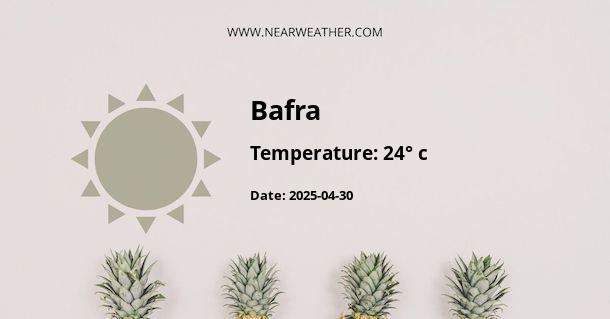Báfra, Greece: Climate and Weather Year Round
Báfra is a beautiful city located in the northeastern part of Greece. It is known for its rich history, charming architecture, and stunning natural landscapes. One important aspect that visitors and residents alike need to consider when planning their activities in Báfra is the climate and weather conditions throughout the year. Understanding the weather patterns can help individuals make informed decisions about what to wear, when to visit, and what activities to engage in. In this article, we will explore the climate and weather of Báfra in detail.
Geographical Location
Báfra is situated on the coast of the Aegean Sea, in the region of East Macedonia and Thrace. It is surrounded by mountains which provide a stunning backdrop to the city. This geographical location has a significant influence on the local climate and weather patterns.
Climate Classification
Báfra experiences a Mediterranean climate, characterized by hot, dry summers and mild, wet winters. This climate classification is determined by factors such as temperature, precipitation, and wind patterns.
Temperature
The temperature in Báfra varies greatly throughout the year. Summers, which span from June to September, are typically hot and dry, with average temperatures ranging from 25°C (77°F) to 35°C (95°F). It is not uncommon for temperatures to exceed 40°C (104°F) during heatwaves. In contrast, winters, which last from December to February, are mild and relatively cool, with average temperatures ranging from 5°C (41°F) to 15°C (59°F).
Spring and autumn are transitional seasons, with temperatures gradually increasing or decreasing. In spring (March to May), temperatures range from 10°C (50°F) to 20°C (68°F), while in autumn (October to November), temperatures range from 15°C (59°F) to 25°C (77°F).
Precipitation
Báfra receives the majority of its rainfall during the winter months. The wettest months are typically December, January, and February, with average rainfall ranging from 50mm to 100mm (2 inches to 4 inches) per month. Spring and autumn are characterized by moderate rainfall, with average precipitation ranging from 25mm to 50mm (1 inch to 2 inches) per month.
Summers in Báfra are generally dry, with very little rainfall. July and August are the driest months, with average precipitation below 10mm (0.4 inches). However, it is worth noting that sporadic thunderstorms can occur during the summer months, bringing brief but heavy showers.
Sunshine Hours
Báfra enjoys a significant amount of sunshine throughout the year, with an average of 2,800 to 3,000 hours of sunshine annually. The sunniest months are typically July and August, with an average of 12 to 13 hours of sunshine per day.
Wind Patterns
The wind patterns in Báfra are influenced by its coastal location. During the summer months, a prevailing wind called the Meltemi blows from the north, providing a refreshing breeze and relief from the heat. In the winter, the wind patterns can vary, with gusts of wind occasionally reaching higher speeds.
Best Time to Visit
The best time to visit Báfra largely depends on individual preferences and the type of activities planned. For those who enjoy warm weather and outdoor activities, the summer months of June to September are ideal. However, it is important to note that temperatures can be quite high during this time, so it is essential to stay hydrated and protect oneself from the sun.
If you prefer milder temperatures and wish to avoid the crowds, the spring and autumn months of March to May and October to November are recommended. These seasons offer pleasant weather for exploring the city and its surroundings.
Winter, although mild, may not be the best time for outdoor activities due to the higher chance of rainfall. However, it can be an excellent time to experience the city's cultural events and indulge in local cuisine.
Conclusion
Báfra, Greece, experiences a Mediterranean climate with hot, dry summers and mild, wet winters. The temperature ranges from 5°C (41°F) to 40°C (104°F), with the hottest months being June to September. Rainfall is highest during the winter months, with the wettest period being December to February. The city enjoys ample sunshine, with an average of 2,800 to 3,000 hours of sunshine annually. The best time to visit Báfra depends on personal preferences, with the summer months offering warm weather for outdoor activities and the spring and autumn months providing milder temperatures.
A - Bafra's Latitude is 39.599998 & Longitude is 20.878330.
A - Weather in Bafra is 24° today.
A - Climate Conditions in Bafra shows clear sky today.
A - Humidity in Bafra is 17% today.
A - Wind speed in Bafra is 12.96 km/h, flowing at 130° wind direction. today.
